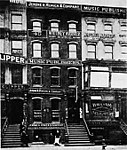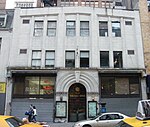28th Street station (IRT Sixth Avenue Line)
1892 establishments in New York (state)1938 disestablishments in New York (state)Defunct New York City Subway stations located abovegroundFormer elevated and subway stations in ManhattanIRT Sixth Avenue Line stations ... and 4 more
Manhattan railway station stubsRailway stations closed in 1938Railway stations in the United States opened in 1892Sixth Avenue

28th Street was a station on the demolished IRT Sixth Avenue Line in Manhattan, New York City. It had two tracks and two side platforms. It was served by trains from the IRT Sixth Avenue Line. This station opened in 1892. From 1910 to 1937 it also had a connection to the 28th Street (H&M station). It closed on December 4, 1938. The next southbound stop was 23rd Street. The next northbound stop was 33rd Street.
Excerpt from the Wikipedia article 28th Street station (IRT Sixth Avenue Line) (License: CC BY-SA 3.0, Authors, Images).28th Street station (IRT Sixth Avenue Line)
6th Avenue, New York Manhattan
Geographical coordinates (GPS) Address Nearby Places Show on map
Geographical coordinates (GPS)
| Latitude | Longitude |
|---|---|
| N 40.746022222222 ° | E -73.990522222222 ° |
Address
The Aston
6th Avenue 800
10001 New York, Manhattan
New York, United States
Open on Google Maps







